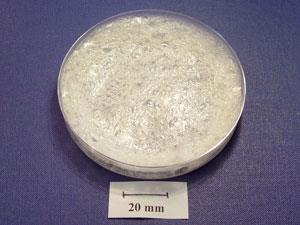Persistent foams stabilise the possibility of oceanic mirrors that boost planetary albedo

Long-life foams that can act as oceanic mirrors are being explored by scientists in the UK. These reflective foams could one day ease global warming by managing incoming solar radiation.
Planetary albedo is the proportion of sunlight reflected by Earth’s surface; two main areas contribute – land and ocean. Oceanic albedo is primarily caused by naturally occurring bubbles or foams produced by surface waves called whitecaps. They create an oceanic mirror but without them, ocean reflectance is only around 5%. Whitecaps, however, are short-lived, urging research into persistent foams that boost albedo.
Julian Evans’ group at University College London have been investigating just that. They found that protein only solutions gave reflective foams with insufficiently short lifetimes. However, adding high methyl ester (HM) pectin to type A gelatin created a foam with a lifetime of 12 weeks in salt water and a reflectance comparable to that of whitecaps at 50–54%.
Evans says the problem with ocean foam is it needs a lot of energy to make and doesn’t last long: ‘So everything depends on its lifetime. We have been looking at additives that could, at around the 1wt% level, be used to make long-lived foams.’ Combining methyl cellulose with polysaccharides from the carrageenan family was also found to yield a long-lasting foam, held together by electrostatic interactions, which is capable of achieving a reflectance of 65–75%. Carrageenans are naturally found in red seaweeds, thus limiting the inclusion of externally derived ingredients in the foam.
Biodegradable and non-toxic additives edge the technology closer to application but an engineered oceanic mirror is still a long way off. Evans explains that there is further work to be carried out investigating wave action, gelation conditions and the use of ocean-sourced proteins.
‘Among the many emerging climate remediation strategies it is probably one of the least damaging,’ he says, ‘but people want a solution to climate change that has no costs, monetary or environmental, so I fear that they may be disappointed.’
Nonetheless, experts in the field are excited by the study. Rossen Sedev, a surfactant and colloidal systems researcher, from the University of South Australia, describes the work as ‘a down-to-Earth sensible consideration of what foam science could do to help us slow down the overheating of our world.’ And complex fluids expert Ranjini Bandyopadhyay, from the Raman Research Institute in Bangalore, India, says ‘this is another fantastic example of how effectively complex fluid systems can be used to solve some of the urgent problems that face us today.’
References
This article is free to access until 10 December 2014. Download it here:
A Aziz et al, RSC Adv., 2014, 4, 53028 (DOI: 10.1039/c4ra08714c)






No comments yet